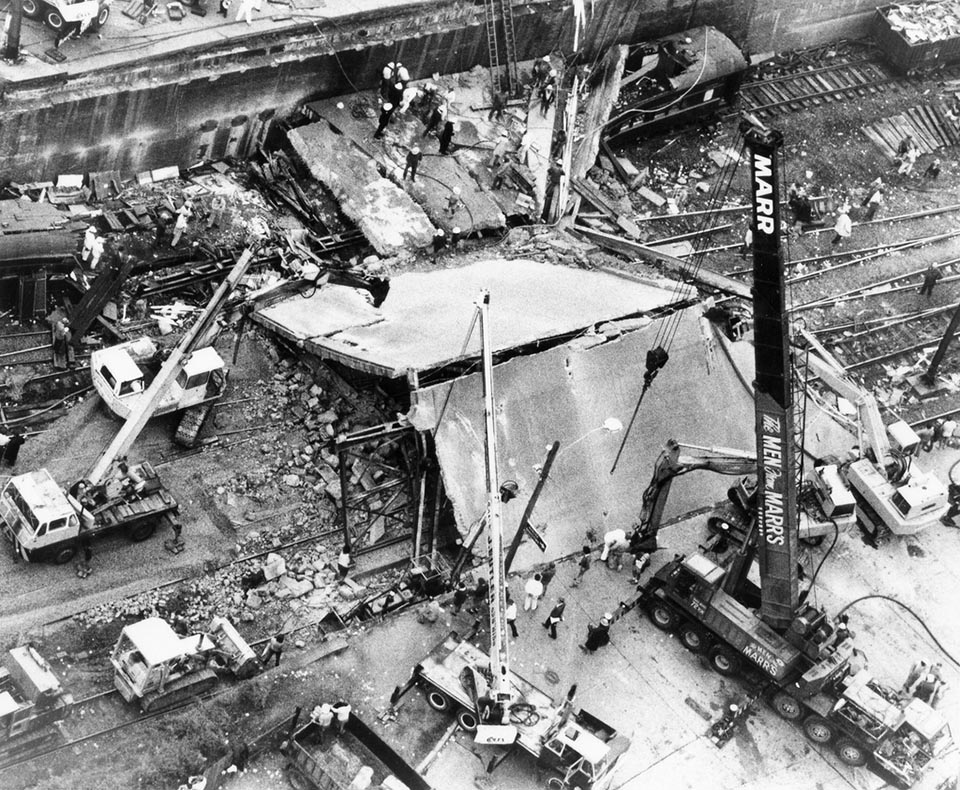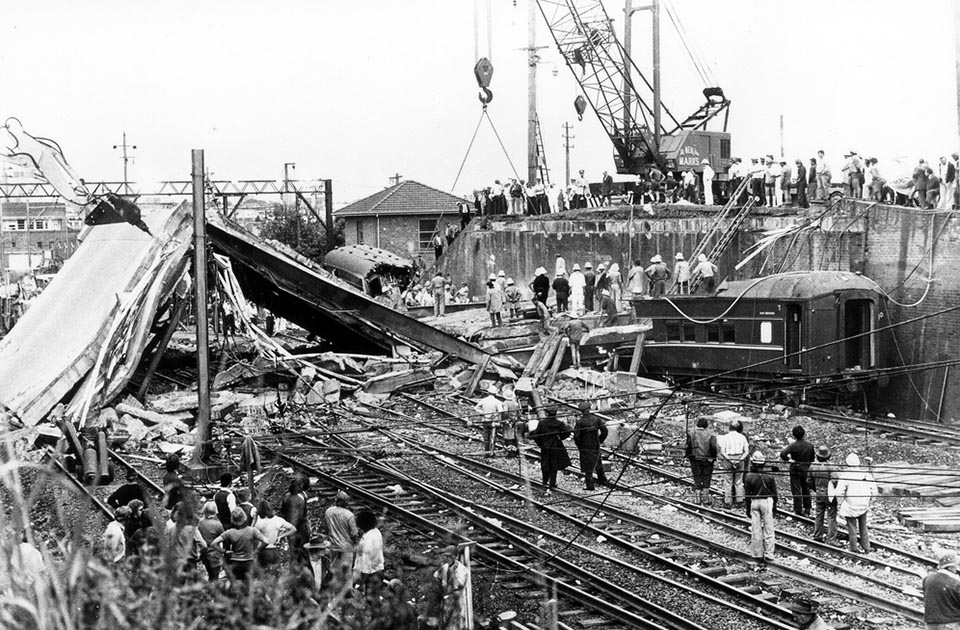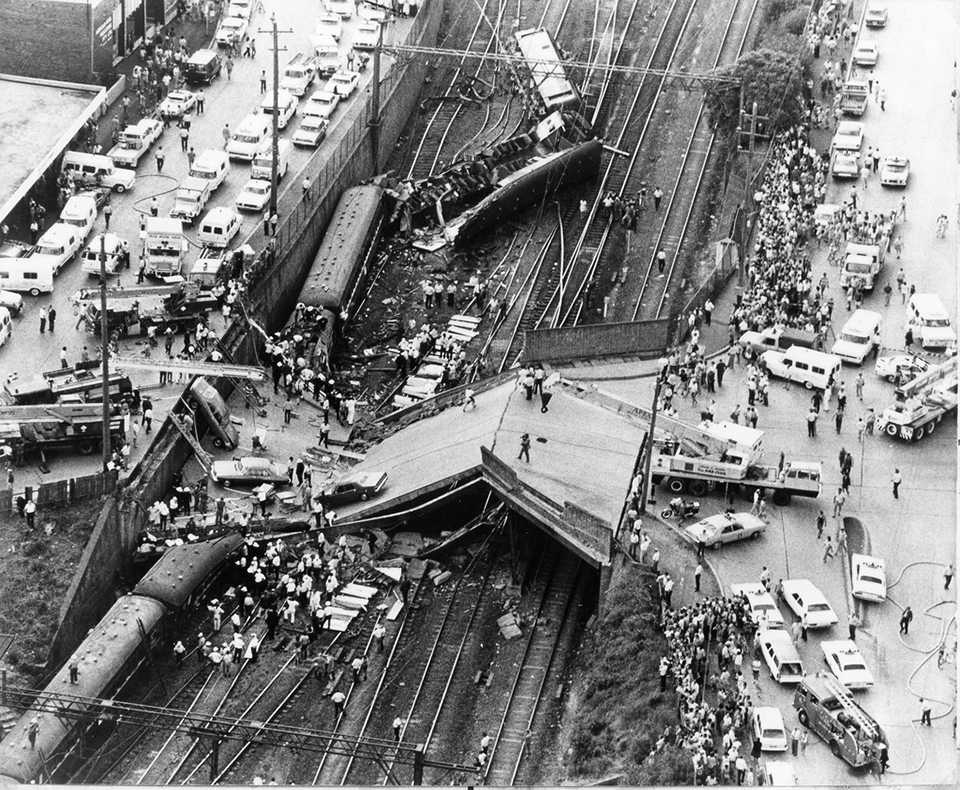The Dictionary of Sydney was archived in 2021.
Granville rail disaster 1977
Citation
Persistent URL for this entry
To cite this entry in text
To cite this entry in a Wikipedia footnote citation
To cite this entry as a Wikipedia External link
Granville rail disaster 1977
‘the locomotive proceeded in an uncontrolled and uncontrollable condition…’[1]
[media]The Granville rail disaster was the worst rail accident in Australian history, with a staggering 83 people killed and 210 people injured.
[media]On 18 January 1977 at 6:09am the No.108 train departed from the Blue Mountains towards its Sydney terminus.[2] By 8:00, there were approximately 469 commuters aboard. Only ten minutes later, the locomotive hit an 80km/h curve in the tracks at Granville and derailed, ploughing into the supports of a nearby bridge and collapsing onto its side. The first carriage hit a power mast, shearing it off at the base and killing eight people. The second carriage came to rest east of the bridge, with no serious injuries reported. At this point, the bridge gave way, raining a combined weight of 570 tonnes of wreckage onto the third and fourth carriages. Both carriages were crushed, with 75 passengers killed. The driver and fireman inside the locomotive both survived.
[media]Though signalmen were alerted to the accident seconds after it happened, the sheer scale of the disaster meant that the rescue operation was extremely difficult. Volunteer teams worked alongside police, the fire brigade, ambulance officers, hospital workers, railway personnel and the Department of Main Roads to cut through the concrete slab of the bridge, alert to the danger of further collapses or ignition of the train heating system. The last body was retrieved over thirty hours after the accident.
Only three days after the derailing, a formal government investigation under judge James Staunton was launched. A total of 75 witnesses were called and over 350 documents examined during the investigation, which found that a combination of poor trackwork, supervision and railway maintenance had contributed to the accident. Justice Staunton stated that ‘derailment of some vehicles was almost inevitable so long as the poor condition of the track remained uncorrected’. [3] The bridge, which was unable to support itself on a single set of supports, was determined as the secondary cause of the accident. A coronial inquiry was also undertaken at the Glebe Coroner’s Court by Sydney City Coroner Thomas Weir, which cleared the driver of any wrongdoing.[4] The two-week inquiry found that six factors contributed to the accident, including the poor condition of the railway tracks, the angle of wear on the rail and leading wheels of the locomotive and the capacity of lateral rail movement.[5] Mr Weir also praised the work of the rescuers.
Following the conclusion of the government investigation and coronial inquiry, the NSW Government made a substantial increase in their rail maintenance expenditure. The Labor government under Premier Neville Wran announced a $200 million track upgrade project in June 1977, with the state’s railways substantially improved throughout the 1980s.[6]
Notes
[1] Judge J.H Staunton, 1977. Formal Investigation of an Accident on or about the Up Main Western Railway Line at Granville on 18th January, 1977. NSW Parliamentary Papers (NSW PP), 1976-77-78. Vol.10, pp.1106-1107.
[2] Judge J.H Staunton, 1977. Formal Investigation of an Accident on or about the Up Main Western Railway Line at Granville on 18th January, 1977. NSW Parliamentary Papers (NSW PP), 1976-77-78. Vol.10, pp.1106-1107.
[3] ‘Granville; track maintenance to blame’, Tribune 8 June 1977, 3. http://nla.gov.au/nla.news-article259733530, viewed 19 November 2020
[4] ‘Driver not at fault: coroner’, The Canberra Times 1 July 1977, 10. http://nla.gov.au/nla.news-article110855902, viewed 19 November 2020>.
[5] ‘Coroner finds six factors caused crash’, The Canberra Times 23 July 1977, 6. http://nla.gov.au/nla.news-article110856312, viewed 19 November 2020>.
[6] ‘$200m to be spent on NSW rail track’, The Canberra Times 2 June 1977, 7. http://nla.gov.au/nla.news-article110848480, viewed 19 November 2020>.




